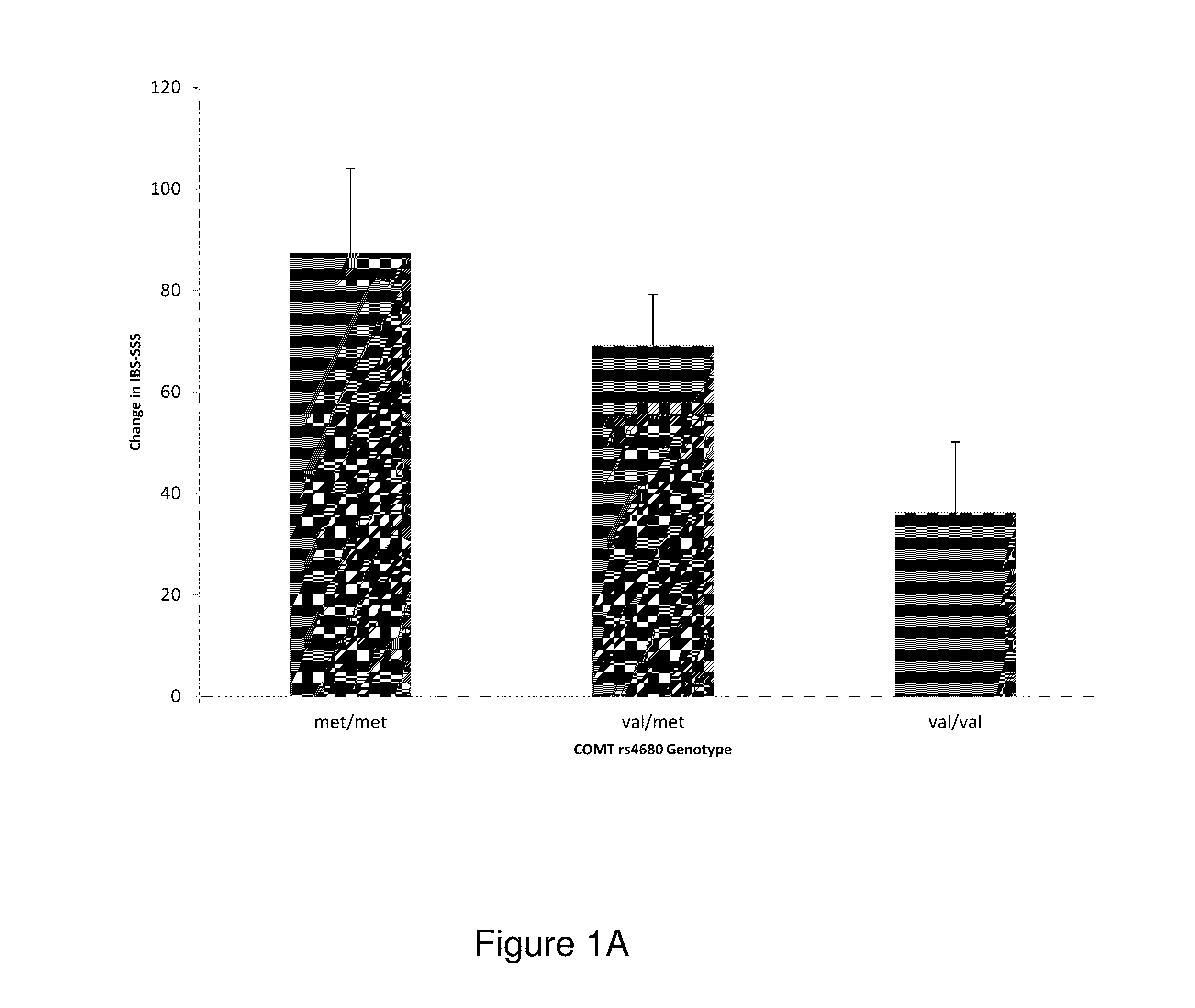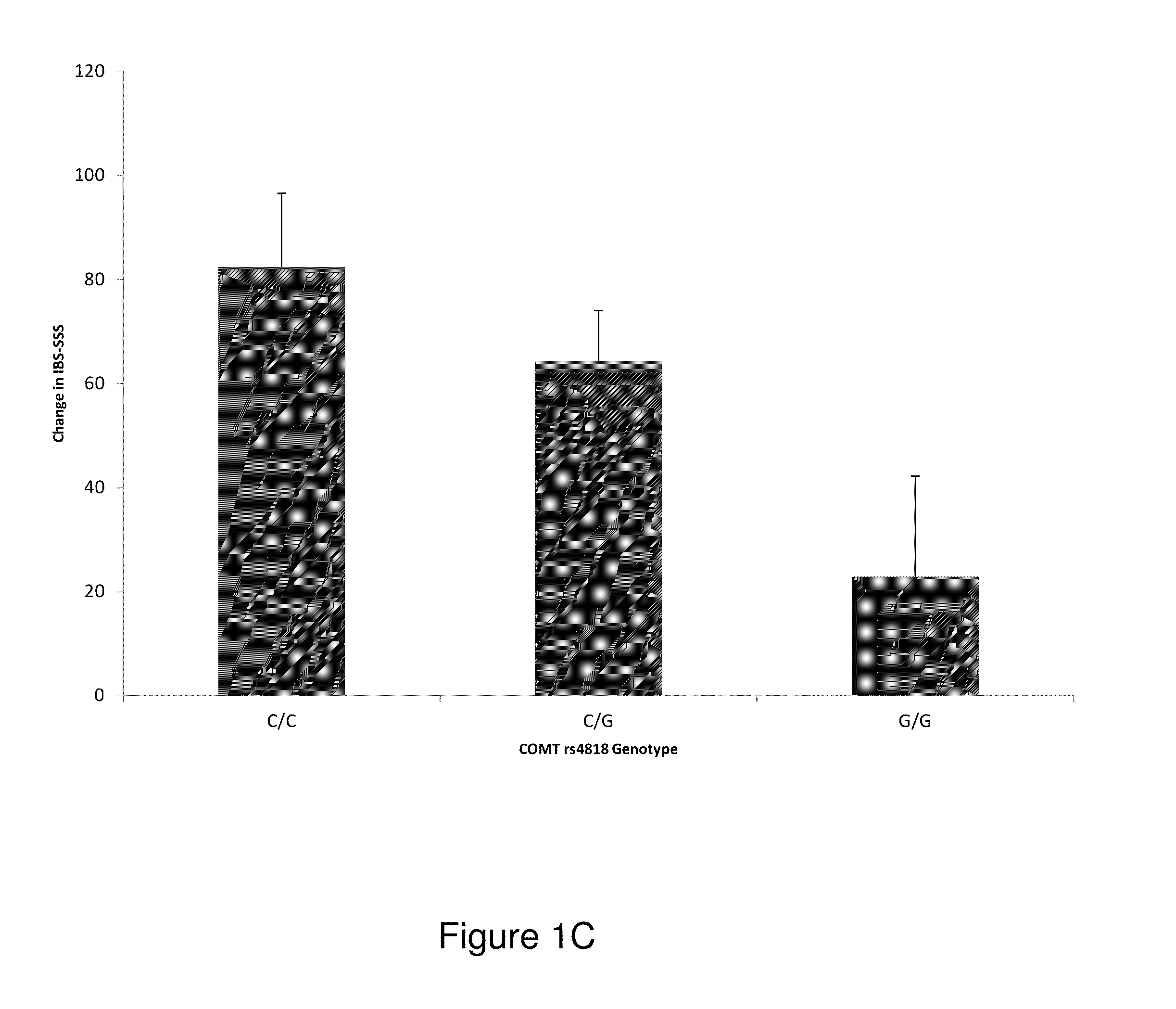Methods and kits for determining a placebo profile in subjects for clinical trials and for treatment of patients
a clinical trial and placebo technology, applied in the field of clinical trial subjects and patients, can solve the problems of not being able to further develop the evidence of early efficacy, presenting both opportunities and significant issues, and significantly affecting the success of the development of new therapeutic interventions
- Summary
- Abstract
- Description
- Claims
- Application Information
AI Technical Summary
Benefits of technology
Problems solved by technology
Method used
Image
Examples
example 1
Irritable Bowel Syndrome
Materials and Methods
[0124]A randomized clinical trial investigating placebo effects in IBS patients (Trial registration—NCT00065403) was conducted. Details of the design and outcomes of the trial are provided elsewhere. The 3-week trial enrolled 262 patients (75% women) ≧18 years and diagnosed by IBS Rome II criteria score of >150 on the Irritable Bowel Syndrome Symptom Severity Scale (IBS-SSS).
[0125]Patients were randomized to one of three treatment arms: (1) no-treatment control (“waitlist); (2) placebo acupuncture (“limited”); (3) placebo acupuncture plus a supportive patient-provider (“augmented”). A validated sham acupuncture device was used to deliver placebo acupuncture in 20 minute sessions, twice weekly for three weeks.
[0126]A subgroup of patients (n=112) gave consent for genetic analysis from blood samples included in this study. The Institutional Review Board at Beth Israel Deaconess Medical Center (Boston, Mass.) approved the main study and the g...
example 2
Association of COMT Genotype with a Placebo Response to Pain
[0139]FIG. 4 is a bar graph showing the response of subjects to a pain stimulus in the presence of an analgesic placebo cue. Subjects were exposed to low or high, local heat stimulus on their forearm. During a conditioning phase the subjects learned to distinguish between a high heat and a low heat pain stimulus which was accompanied by a cue card describing the pain sensation that should be expected as “low” or “high”. In the next phase, subjects received low or high pain stimuli. In a randomized manner some of the high pain administrations were accompanied by a cue card predicting a “low” pain stimulus. This is the equivalent of a placebo analgesic. The bar graph shows the correlation of a positive response to this placebo analgesic correlated to the rs4818 COMT genotypes of the tested subjects. The ρ value in the 46 subjects tested is 0.058.
example 3
Clinical Trial with Placebo Prescreen
[0140]Thase and colleagues (Arch Gen Psychiatry, vol 53, pp. 777-784, 1996) found that sertraline produced a clinical improvement in 59% of the 416 dysthymic patients and that the corresponding placebo treatment produced improvement in 44% of the 416 patients. The required numbers of patients for statistically significant demonstration of efficacy over placebo can be largely reduced, compared to non-prescreened trials. Prescreening patients for Met / Met and their subsequent exclusion from the clinical trial can result in placebo reduction. Using Fisher's exact test (two-tailed with α=5%), a total of 366 patients would be needed to have 80% power to detect a significant effect of medication over placebo. This example is based on the Thase sertraline (Zoloft) study. However, by identifying likely placebo responders and reducing the proportion of placebo responders to 24%, a study of only 72 patients would be needed to achieve 80% power. By identifyi...
PUM
| Property | Measurement | Unit |
|---|---|---|
| size | aaaaa | aaaaa |
| frequency | aaaaa | aaaaa |
| structure | aaaaa | aaaaa |
Abstract
Description
Claims
Application Information
 Login to View More
Login to View More - R&D
- Intellectual Property
- Life Sciences
- Materials
- Tech Scout
- Unparalleled Data Quality
- Higher Quality Content
- 60% Fewer Hallucinations
Browse by: Latest US Patents, China's latest patents, Technical Efficacy Thesaurus, Application Domain, Technology Topic, Popular Technical Reports.
© 2025 PatSnap. All rights reserved.Legal|Privacy policy|Modern Slavery Act Transparency Statement|Sitemap|About US| Contact US: help@patsnap.com



